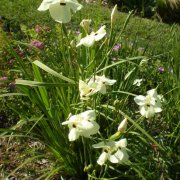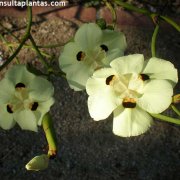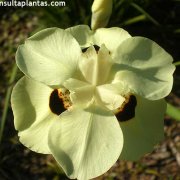Care of the rhizomatous plant Dietes bicolor or Butterfly flag |
|
The genus Dietes, family Iridaceae, includes 6 species of rhizomatous perennial plants native to South Africa. Some species are: Dietes bicolor, Dietes iridioides, Dietes grandiflora, Dietes robinsoniana. Common names: Yellow wild iris, African iris, Butterfly flag, Fortnight lily. This species is native to Cape Province, KwaZulu-Natal. They are perennial rhizomatous herbaceous plants that reach 1 meter (3.28 feet) in height. The leaves are ribbon-shaped and light green in color. The attractive flowers last a few days but appear profusely, they are very pale yellow with highly contrasting dark spots. They bloom in spring and summer but can do so, with less intensity, in autumn. Yellow wild iris is used as isolated specimens, in massifs and on borders; It is also possible to grow it in pots and planters. Dietes bicolor is an easy to grow plant that needs full sun or semi-shade exposure. It resists the cold of Mediterranean and subtropical climates. The soil must be well drained and contain organic matter; add coarse sand and leaf mulch or humus to a garden substrate. Water 2 times a week with 1 glass of water per specimen, waiting for the substrate to dry. African iris has resistance to drought. Fertilize the soil with humus before planting and with mineral fertilizer for bulbous plants every 15 days during flowering. Butterfly flag is a resistant plant to the usual pests and diseases. Fortnight lily propagates by seeds sown in spring or autumn and by division of rhizomes after flowering. |
Images of the rhizomatous plant Dietes bicolor or Butterfly flag |
Find plants
Dietes bicolor or Butterfly flag | Care and Growing
© 2026 FavThemes


